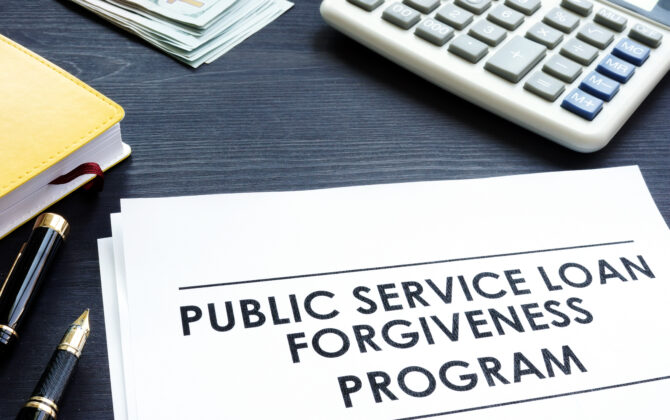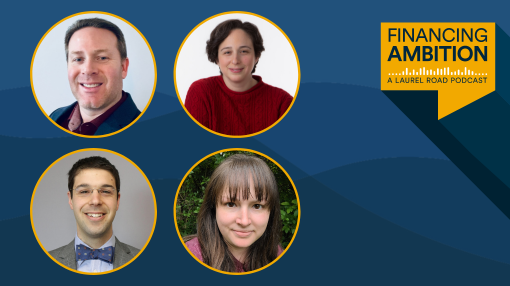The average medical school graduate owes more than $250,000 in total student loan debt. If you’re a new resident or about to head into a residency program, not only can that amount of debt be stressful to think about, but it can also affect the decisions you make about your professional trajectory and where you start your medical career.
Fortunately, for physicians interested in a career in public health, Public Service Loan Forgiveness (PSLF)1 is available to help ease the burden of high student loan debt. The program, which is available to doctors who work for the government or qualifying nonprofit organizations, forgives your remaining student loan balance after ten years (or 120 qualifying payments) of repayment in an Income-driven Repayment (IDR) plan.
Does residency count towards PSLF?
Payments made during your residency could count as qualifying payments towards PSLF as long as you can achieve the following:
- Consolidate all your federal student loans into one Direct Loan. If you want to maximize your potential forgiveness amount and start qualifying payments as soon as possible, it may be smart to get this done during the grace period before repayment begins.
- Enroll in a PSLF-eligible residency program. Don’t assume that working at a hospital means you’re automatically eligible for PSLF – use the employer search tool on studentaid.gov or schedule a free 30-minute consultation with one of our student loan specialists to understand what types of employers qualify for PSLF.
- Enroll in a qualifying repayment plan. Though the Standard Repayment Plan is a qualifying plan for PSLF, residents typically enroll in an Income-Driven Repayment (IDR) plan to help stabilize monthly student loan payments as they pursue PSLF.
Steps residents should take to qualify for PSLF
As a resident interested in pursuing PSLF, there are several steps you should take:
Make sure your loans are Direct Loans
Only Direct Loans are eligible for the PSLF program, however, if you have other federal loan types, such as FFEL, you could consolidate them into Direct Loans to become eligible.
Work for PSLF-eligible employers
Make sure you’re enrolled in a residency program that qualifies for PSLF. Residents working for several different employer types typically qualify for PSLF, including:
- Qualifying nonprofit hospitals or organizations
- State hospital systems
- Federal hospitals
- Public schools, including universities and K-12 school systems
You can find the eligible employer search tool on studentaid.gov here and learn more about types of jobs that qualify for PSLF here.
Be sure to submit the PSLF eligibility form each year and track your progress
For each year you’re enrolled in PSLF, you should recertify your employment and family size. Submitting an employment certification form (ECF) each year creates a paper trail and makes it much easier to confirm your eligibility for forgiveness as you near 120 qualifying payments.
For guidance and help with program requirements, consider contacting our student loan specialists or exploring our Student Loan Freedom solutions. Our specialists can help with eligibility and the annual recertification for PSLF, keep you up-to-date on any changing requirements, and track your progress toward forgiveness.
Choose the right repayment plan
One of the requirements for PSLF is enrollment in a qualifying repayment plan, such as an IDR plan. IDR plans calculate repayment structures based on a borrower’s adjusted gross income and family size.
IDR Comparison Chart
|
Applications for SAVE, other IDR plans, and loan consolidation are available on http://studentaid.gov. You can also submit a PDF application to your loan servicer by uploading it to your servicer’s website, or mailing it to them. Expect a delay in processing times. The Education Department recommends checking its website for updates – there is no processing time estimate available. |
|
Plan |
Monthly Payments |
Repayment Period |
Status |
|
SAVE (formerly REPAYE) |
- 5% of discretionary income for Undergraduate Loans
- 10% of discretionary income for Graduate Loans
- Weighted average for borrowers who have both
|
- 10 years for low-balance borrowers (less than $12,000)
- 20 years for only undergraduate loans
- 25 years for any Graduate Loans
|
Replaced REPAYE |
|
Income-Based Repayment (IBR) |
- 10-15% of your discretionary income (and your spouse’s if filing jointly)
- Never more than federal 10-year Standard Repayment Plan amount
|
20-25 years, depending on when you become a new borrower |
Remains available but borrowers cannot select plan after 60 payments on REPAYE that occur on/after July 1, 2024 |
|
Income-Contingent Repayment (ICR) |
The lesser of the following: - 20% of your discretionary income or
- What you would pay on a repayment plan with a fixed payment over the course of 12 years, adjusted according to your income
|
25 years |
Not accepting enrollments for current students; only available to future borrowers with consolidated Parent PLUS loans |
|
Pay as You Earn (PAYE) |
- 10% of your discretionary income (and your spouse’s if filing jointly)
- Never more than federal 10-year Standard Repayment Plan amount
|
20 years |
Not accepting new enrollments |
Learn more about and compare IDR plan options here and schedule a free consultation with our student loan specialists to determine which plan is right for based on your financial profile and employment.
Additionally, the different IDR plans you could enroll in as part of the PSLF program come with their own pros and cons as well. Learn more here.
Taking advantage of PSLF during residency
For many residents passionate about pursuing a career in public health, PSLFsignificantly eases the burden of student loan debt and makes it possible to achieve their career goals.
However, many medical professionals still find the process of applying for the program as well as the annual recertification required to be time-consuming and tricky to navigate. If you think you could qualify for federal student loan forgiveness, start off by understanding what types of federal student loans you have and if you need to consolidate them. You should also gather the following documentation:
- A verified FSA ID – the account username and password that allows students (and parents) to identify themselves electronically to access US Department of Education systems.
- Your financial information
- Your personal information
- Your spouse’s information (if applicable)
If you’re starting the PSLF application process ahead of or during your residency, some extra guidance can help save you time and give you peace of mind during this transitional time in your life and career. Schedule a free consultation with one of our student loan specialists to get your questions about PSLF answered from a knowledgeable guide.




